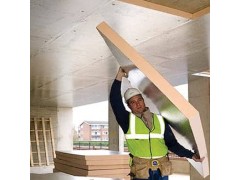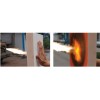PHENOLIC INSULATION BOARD
Phenolic insulation is manufactured by a process in which a plastic foam forms an insulating core between two flexible tissue faced layers. It has a high closed cell content and fine cell structure.
Rigid phenolic insulation is produced by mixing high solids and phenolic resin with a surface acting agent. The heat created by the reaction evaporates a volatile liquid blowing agent in the mixture which produces a network of small bubbles in the material. The foam can be cured to create one of two forms of the product. It can be manufactured by a continuous process to create thin sheet material which is laminated with various facings and cut into boards.
Wetherby use the fujiantenlead K5-EWB External Insulation Wall Board in the majority of their systems.
PHENOLIC INSULATION – THERMAL PERFORMANCE
Rigid phenolic insulation products offer very good thermal insulating properties due to the very low thermal conductivity of phenolic foam, compared with rigid polyurethane or extruded polystyrene. It can actually be 50% more effective than other common insulation materials. Its low thermal conductivity allows specified thermal performance targets to be achieved with minimal thickness of insulation. This is particularly significant where space saving is
PHYSICAL QUALITIES OF PHENOLIC INSULATION
STRUCTURE
Rigid Phenolic insulation has a high closed cell content and fine cell structure. It is lightweight, easy to transport , handle and install.
COMPRESSIVE STRENGTH
Phenolic foams are produced with densities in the range of 35 kg/m³ to 200 kg/m³. High density boards have a good compressive strength and are suitable for some floors.
MATERIAL RESISTANCE
Rigid phenolic insulation is resistant to fungus and mould growth and will not sustain vermin.
HEAT RESISTANCE
Rigid phenolic insulation can withstand continuous temperatures of up to 120 degrees C.
MOISTURE RESISTANCE
Moisture has a minimal effect on its thermal performance. Rigid phenolic insulation has a 95% (or greater) closed cell content which makes it highly resistant to moisture penetration. It also has a low water vapour permeance. Phenolic foam is also non-wicking. This means that if water enters the insulation system due to the vapour barrier becoming punctured, any moisture ingress is limited and confined to the punctured area. This ensures moisture does not build up and compromise the whole system.
STABILITY
Rigid phenolic is dimensionally stable and can be cut accurately to achieve a snug fit in situations such as between rafters where airtightness will be improved.
HIGH TEMPERATURES
Rigid phenolic insulation can withstand continuous temperatures of up to 120 degrees C.
FIRE PERFORMANCE
The fire performance of phenolic foam is exceptional. It combines zero or very low flame spread with negligible smoke emission and a very low level of toxic gas emission. Phenolic foams which have very low thermal conductivities are used as alternatives to PUR or PIR foams where a self extinguishing, low smoke emission, material is required. Insulating materials are rigorously tested to British Standards and fire performance data, to meet the requirements of building regulations, is generally available from manufacturers.
RECYCLING
Rigid phenolic insulation is non- biodegradable but waste material can be put back into the manufacturing process for reuse.
THERMAL PROPERTIES OF PHENOLIC INSULATION
The λ−values and R−values detailed below are quoted in accordance with BS / I.S. EN 13166: 2008 (Thermal insulation products for buildings – Factory made products of phenolic foam (PF) – Specification).
THERMAL CONDUCTIVITY
The boards achieve a thermal conductivity (λ–value) of:
- 0.023 W/m.K (insulant thickness 15–24 mm);
- 0.021 W/m.K (insulant thickness 25–44 mm); and
- 0.020 W/m.K (insulant thickness ≥ 45 mm).
THERMAL RESISTANCE
Thermal resistance (R–value) varies with thickness and is calculated by dividing the thickness of the board (expressed in metres) by its thermal conductivity. The resulting number is rounded down to the nearest 0.05 (m2.K/W).
INSULANT THICKNESS THERMAL RESISTANCE
| (mm) | (m2.K/W) |
|---|---|
| 20 | 0.85 |
| 25 | 1.15 |
| 30 | 1.40 |
| 35 | 1.65 |
| 40 | 1.90 |
| 45 | 2.25 |
| 50 | 2.50 |
| 55 | 2.75 |
| 60 | 3.00 |
| 70 | 3.50 |
| 75 | 3.75 |
| 80 | 4.00 |
| 90 | 4.50 |
| 100 | 5.00 |
| 110 | 5.50 |
| 120 | 6.00 |
| 125 | 6.25 |
ENVIRONMENTAL BENEFITS OF PHENOLIC INSULATION
- Phenolic foam has very low embodied energy per unit thermal performance
compared to other insulation material. - Significant CO2 savings can be achieved compared to other insulation materials.
- Phenolic foam can make a significant contribution to help achieve CO2
emission reduction targets required by the Kyoto Protocol. - Phenolic foam ins available in both CFC and HCFC free forms.
- For NBS Plus Information, click here: NBS Plus







